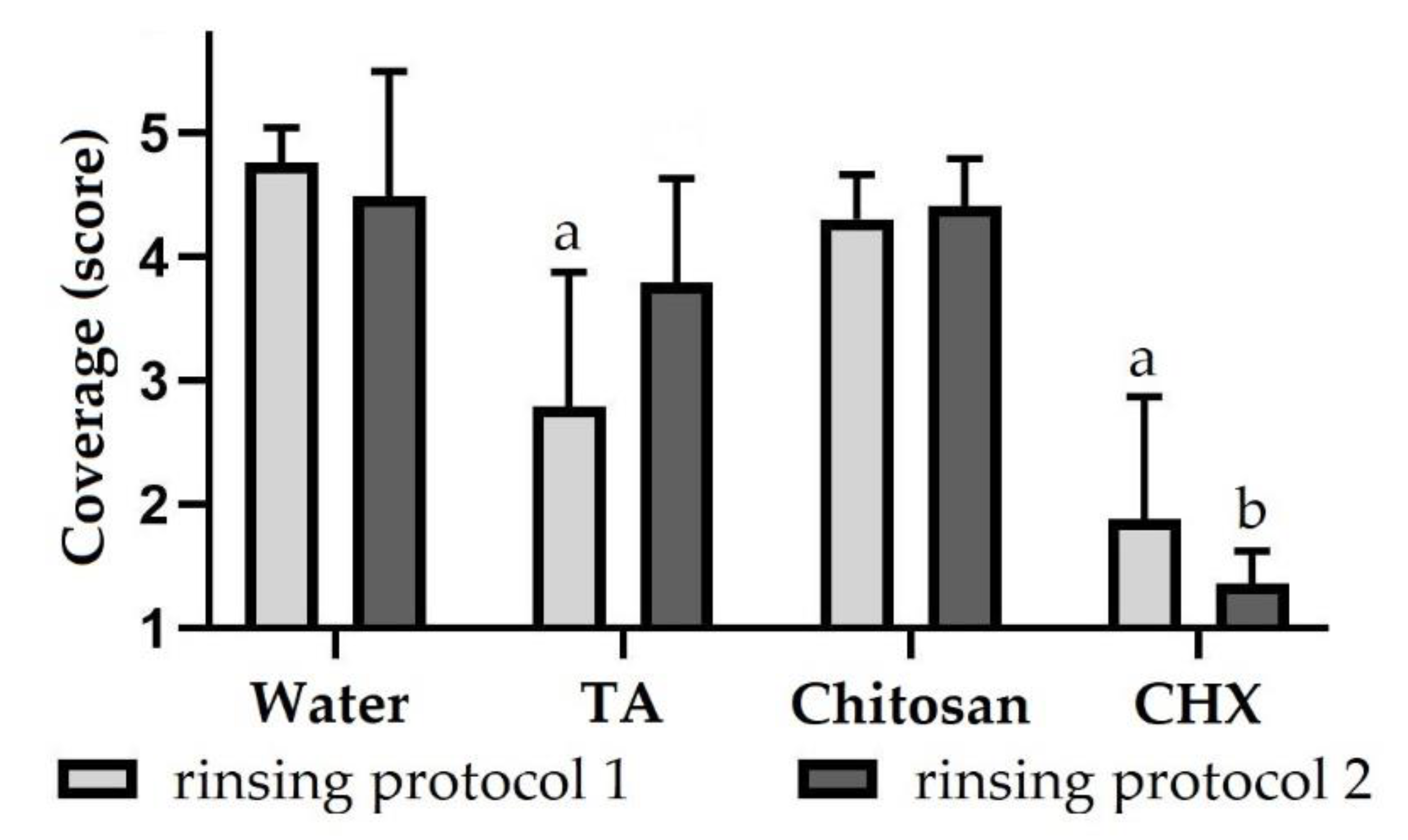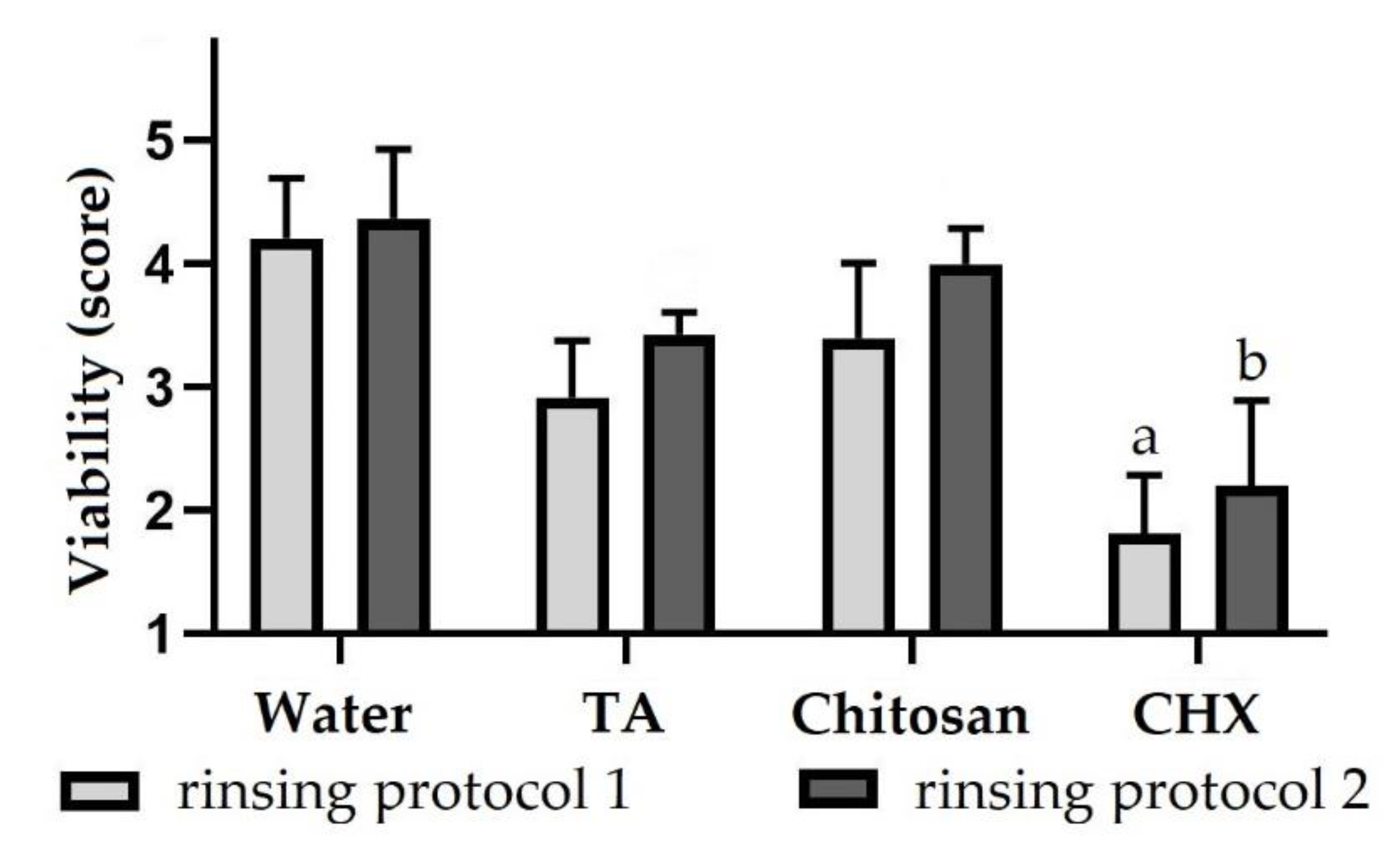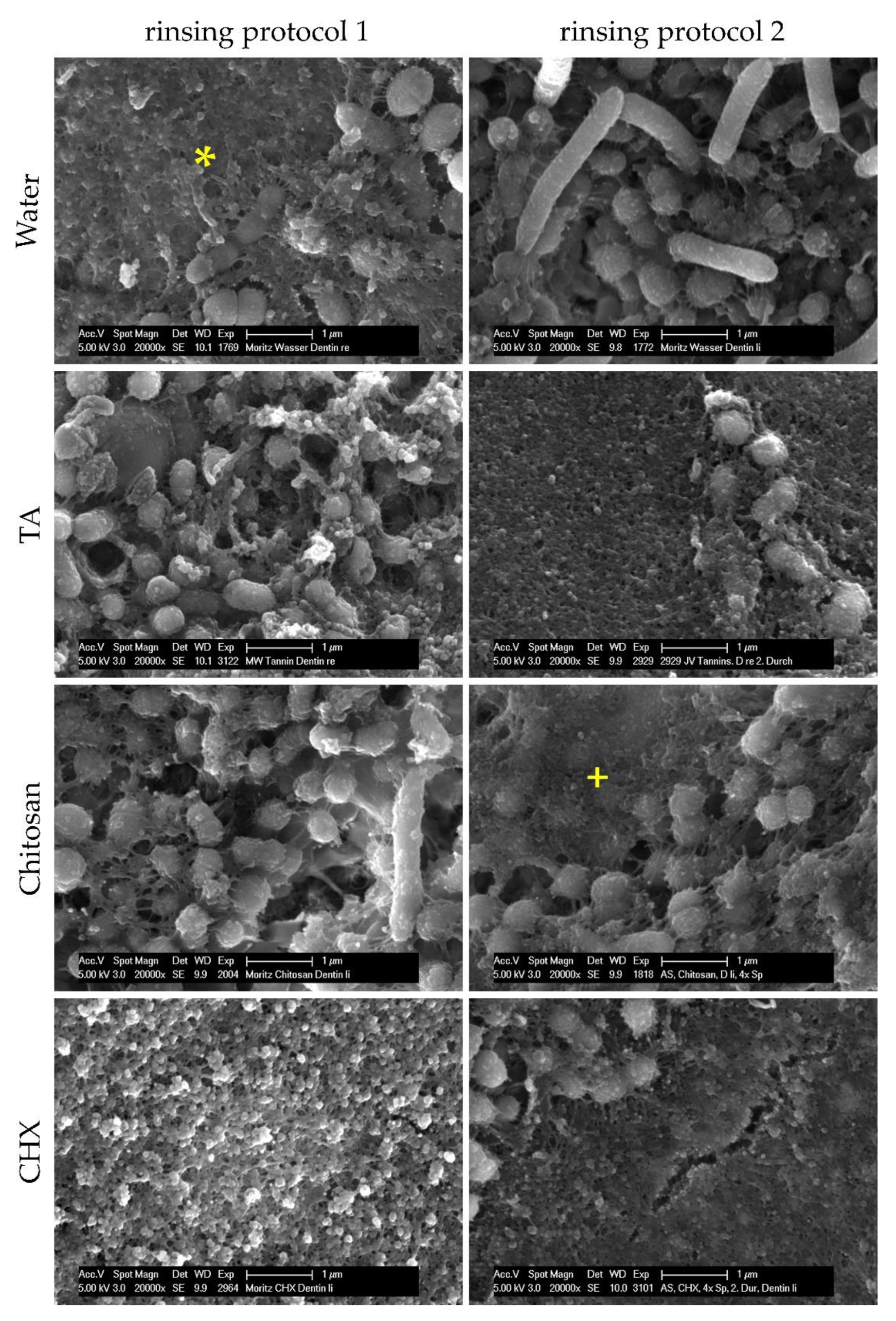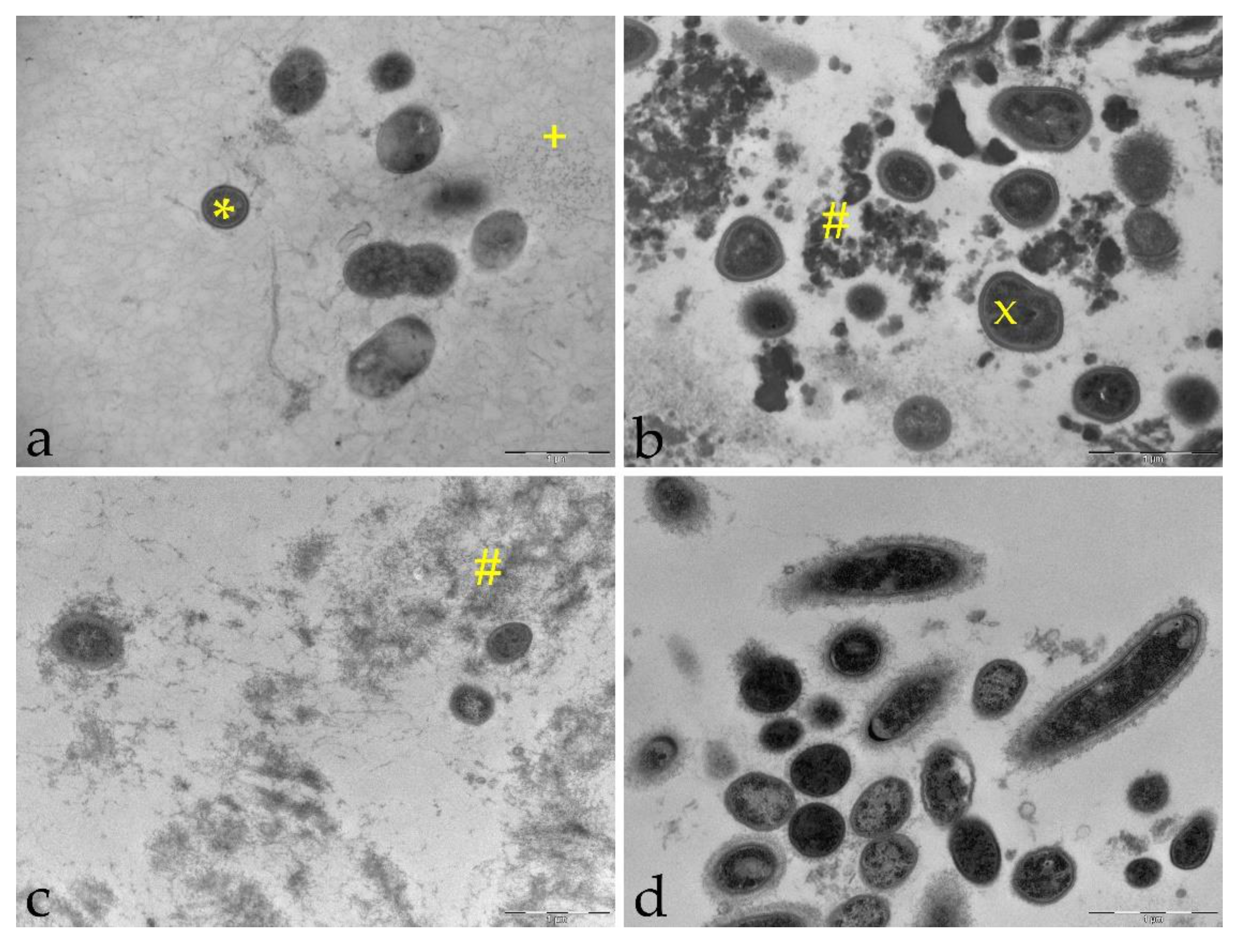Evaluation of Anti-Biofilm Activity of Mouthrinses Containing Tannic Acid or Chitosan on Dentin In Situ
Abstract
1. Introduction
2. Results
2.1. FM Analysis of the Biofilm
2.2. SEM Analysis of the Biofilm
2.3. FM Analysis of Saliva Samples
2.4. TEM Analysis of Saliva Samples
3. Discussion
4. Materials and Methods
4.1. Subjects and Test Substances
4.2. Specimens for Biofilm Formation
4.3. Biofilm Formation In Situ
4.4. FM Analysis of the Biofilm
4.5. SEM Analysis of the Biofilm
4.6. FM Analysis of Saliva Samples
4.7. TEM Analysis of Saliva Samples
4.8. Statistical Analysis
5. Conclusions
Supplementary Materials
Author Contributions
Funding
Institutional Review Board Statement
Informed Consent Statement
Data Availability Statement
Acknowledgments
Conflicts of Interest
Sample Availability
References
- Kassebaum, N.J.; Smith, A.G.C.; Bernabé, E.; Fleming, T.D.; Reynolds, A.E.; Vos, T.; Murray, C.J.L.; Marcenes, W. Global, Regional, and National Prevalence, Incidence, and Disability-Adjusted Life Years for Oral Conditions for 195 Countries, 1990–2015: A Systematic Analysis for the Global Burden of Diseases, Injuries, and Risk Factors. J. Dent. Res. 2017, 96, 380–387. [Google Scholar] [CrossRef]
- Hu, D.; Hong, X.; Li, X. Oral Health in China—Trends and Challenges. Int. J. Oral Sci. 2011, 3, 7–12. [Google Scholar] [CrossRef] [PubMed]
- Niessen, L.C.; Weyant, R.J. Causes of Tooth Loss in a Veteran Population. J. Public Health Dent. 1989, 49, 19–23. [Google Scholar] [CrossRef] [PubMed]
- Selwitz, R.H.; Ismail, A.I.; Pitts, N.B. Dental Caries. Lancet 2007, 369, 51–59. [Google Scholar] [CrossRef]
- Figuero, E.; Nobrega, D.F.; García-Gargallo, M.; Tenuta, L.M.; Herrera, D.; Carvalho, J.C. Mechanical and Chemical Plaque Control in the Simultaneous Management of Gingivitis and Caries: A Systematic Review. J. Clin. Periodontol. 2017, 44, S116–S134. [Google Scholar] [CrossRef]
- Marinho, V.C.; Higgins, J.; Logan, S.; Sheiham, A. Fluoride Toothpastes for Preventing Dental Caries in Children and Adolescents. Cochrane Database Syst. Rev. 2003. [Google Scholar] [CrossRef] [PubMed]
- Löe, H. Oral Hygiene in the Prevention of Caries and Periodontal Disease. Int. Dent. J. 2000, 50, 129–139. [Google Scholar] [CrossRef] [PubMed]
- Kour, K.; Kaur, S.; Singh, P. Comparative Evaluation of the Efficacy of Chlorohexidine Mouthwash as a Supplement to Regular Tooth Brushing. Int. J. Oral Health Dent. 2019, 5, 97–103. [Google Scholar] [CrossRef]
- Bonesvoll, P.; Lökken, P.; Rölla, G.; Paus, P.N. Retention of Chlorhexidine in the Human Oral Cavity after Mouth Rinses. Arch. Oral Biol. 1974, 19, 209–212. [Google Scholar] [CrossRef]
- Rölla, G.; Melsen, B. On the Mechanism of the Plaque Inhibition by Chlorhexidine. J. Dent. Res. 1975, 54, 57–62. [Google Scholar] [CrossRef]
- Reda, B.; Hollemeyer, K.; Trautmann, S.; Hannig, M.; Volmer, D.A. Determination of Chlorhexidine Retention in Different Oral Sites Using Matrix-Assisted Laser Desorption/Ionization-Time of Flight Mass Spectrometry. Arch. Oral Biol. 2020, 110, 104623. [Google Scholar] [CrossRef]
- Mathur, S.; Mathur, T.; Srivastava, R.; Khatri, R. Chlorhexidine: The Gold Standard in Chemical Plaque Control. Natl. J. Physiol. Pharm. Pharmacol. 2011, 1, 45. [Google Scholar]
- Marsh, P.D. Controlling the Oral Biofilm with Antimicrobials. J. Dent. 2010, 38, S11–S15. [Google Scholar] [CrossRef]
- Groppo, F.C.; Bergamaschi, C.d.C.; Cogo, K.; Franz-Montan, M.; Motta, R.H.L.; Andrade, E.D. Use of Phytotherapy in Dentistry. Phytother. Res. 2008, 22, 993–998. [Google Scholar] [CrossRef]
- Newman, D.J.; Cragg, G.M. Drugs and Drug Candidates from Marine Sources: An Assessment of the Current “State of Play”. Planta Med. 2016, 82, 775–789. [Google Scholar] [CrossRef] [PubMed]
- Lewis, W.H.; Elvin-Lewis, M.P. Medical Botany: Plants Affecting Human Health, 2nd ed.; John Wiley & Sons: Hoboken, NJ, USA, 2003; ISBN 0-471-62882-4. [Google Scholar]
- Jeon, J.-G.; Rosalen, P.; Falsetta, M.; Koo, H. Natural Products in Caries Research: Current (Limited) Knowledge, Challenges and Future Perspective. Caries Res. 2011, 45, 243–263. [Google Scholar] [CrossRef]
- Cheng, L.; Li, J.; He, L.; Zhou, X. Natural Products and Caries Prevention. Caries Res. 2015, 49, 38–45. [Google Scholar] [CrossRef] [PubMed]
- Haslam, E. Natural Polyphenols (Vegetable Tannins) as Drugs: Possible Modes of Action. J. Nat. Prod. 1996, 59, 205–215. [Google Scholar] [CrossRef] [PubMed]
- Scalbert, A. Antimicrobial Properties of Tannins. Phytochemistry 1991, 30, 3875–3883. [Google Scholar] [CrossRef]
- Wu-Yuan, C.D.; Chen, C.Y.; Wu, R.T. Gallotannins Inhibit Growth, Water-Insoluble Glucan Synthesis, and Aggregation of Mutans Streptococci. J. Dent. Res. 1988, 67, 51–55. [Google Scholar] [CrossRef]
- Chung, K.-T.; Wong, T.Y.; Wei, C.-I.; Huang, Y.-W.; Lin, Y. Tannins and Human Health: A Review. Crit. Rev. Food Sci. Nutr. 1998, 38, 421–464. [Google Scholar] [CrossRef]
- Tamba, Y.; Ohba, S.; Kubota, M.; Yoshioka, H.; Yoshioka, H.; Yamazaki, M. Single GUV Method Reveals Interaction of Tea Catechin (−)-Epigallocatechin Gallate with Lipid Membranes. Biophys. J. 2007, 92, 3178–3194. [Google Scholar] [CrossRef] [PubMed]
- Hertel, S.; Pötschke, S.; Basche, S.; Delius, J.; Hoth-Hannig, W.; Hannig, M.; Hannig, C. Effect of Tannic Acid on the Protective Properties of the in Situ Formed Pellicle. Caries Res. 2017, 51, 34–45. [Google Scholar] [CrossRef] [PubMed]
- Xi, Q.; Hoth-Hannig, W.; Deng, S.; Jin, X.; Fu, B.; Hannig, M. The Effect of Polyphenol-Containing Solutions on in Situ Biofilm Formation on Enamel and Dentin. J. Dent. 2020, 102, 103482. [Google Scholar] [CrossRef]
- Kumar, M.N.V.R. A Review of Chitin and Chitosan Applications. React. Funct. Polym. 2000, 46, 1–27. [Google Scholar] [CrossRef]
- Periayah, M.H.; Halim, A.S.; Saad, A.Z.M. Chitosan: A Promising Marine Polysaccharide for Biomedical Research. Pharmacogn. Rev. 2016, 10, 39. [Google Scholar] [CrossRef]
- Wieckiewicz, M.; Boening, K.W.; Grychowska, N.; Paradowska-Stolarz, A. Clinical Application of Chitosan in Dental Specialities. Mini Rev. Med. Chem. 2017, 17, 401–409. [Google Scholar] [CrossRef]
- Fei Liu, X.; Lin Guan, Y.; Zhi Yang, D.; Li, Z.; de Yao, K. Antibacterial Action of Chitosan and Carboxymethylated Chitosan. J. Appl. Polym. Sci. 2001, 79, 1324–1335. [Google Scholar] [CrossRef]
- Dash, M.; Chiellini, F.; Ottenbrite, R.M.; Chiellini, E. Chitosan—A Versatile Semi-Synthetic Polymer in Biomedical Applications. Prog. Polym. Sci. 2011, 36, 981–1014. [Google Scholar] [CrossRef]
- Bae, K.; Jun, E.J.; Lee, S.M.; Paik, D.I.; Kim, J.B. Effect of Water-Soluble Reduced Chitosan on Streptococcus Mutans, Plaque Regrowth and Biofilm Vitality. Clin. Oral Investig. 2006, 10, 102. [Google Scholar] [CrossRef] [PubMed]
- Pasquantonio, G.; Greco, C.; Prenna, M.; Ripa, C.; Vitali, L.A.; Petrelli, D.; di Luca, M.C.; Ripa, S. Antibacterial Activity and Anti-Biofilm Effect of Chitosan against Strains of Streptococcus Mutans Isolated in Dental Plaque. Int. J. Immunopathol. Pharmacol. 2008, 21, 993–997. [Google Scholar] [CrossRef] [PubMed]
- Schestakow, A.; Hannig, M. Effects of Experimental Agents Containing Tannic Acid or Chitosan on the Bacterial Biofilm Formation in Situ. Biomolecules 2020, 10, 1315. [Google Scholar] [CrossRef] [PubMed]
- McKenna, G.; Tsakos, G.; Burke, F.; Brocklehurst, P. Managing an Ageing Population: Challenging Oral Epidemiology. Prim. Dent. J. 2020, 9, 14–17. [Google Scholar] [CrossRef]
- Petti, S.; Scully, C. Polyphenols, Oral Health and Disease: A Review. J. Dent. 2009, 37, 413–423. [Google Scholar] [CrossRef]
- Joiner, A.; Muller, D.; Elofsson, U.M.; Arnebrant, T. Ellipsometry Analysis of the in Vitro Adsorption of Tea Polyphenols onto Salivary Pellicles. Eur. J. Oral Sci. 2004, 112, 510–515. [Google Scholar] [CrossRef]
- Hannig, M.; Joiner, A. The Structure, Function and Properties of the Acquired Pellicle. In Monographs in Oral Science; S. Karger AG: Basel, Switzerland, 2006; Volume 19, pp. 29–64. ISBN 0077-0892. [Google Scholar] [CrossRef]
- Yan, Q.; Bennick, A. Identification of Histatins as Tannin-Binding Proteins in Human Saliva. Biochem. J. 1995, 311, 341–347. [Google Scholar] [CrossRef]
- Schilling, K.M.; Bowen, W.H. Glucans Synthesized in Situ in Experimental Salivary Pellicle Function as Specific Binding Sites for Streptococcus Mutans. Infect. Immun. 1992, 60, 284. [Google Scholar] [CrossRef] [PubMed]
- Sakanaka, S.; Aizawa, M.; Kim, M.; Yamamoto, T. Inhibitory Effects of Green Tea Polyphenols on Growth and Cellular Adherence of an Oral Bacterium, Porphyromonas Gingivalis. Biosci. Biotechnol. Biochem. 1996, 60, 745–749. [Google Scholar] [CrossRef]
- Wolinsky, L.; Mania, S.; Nachnani, S.; Ling, S. The Inhibiting Effect of Aqueous Azadirachta Indica (Neem) Extract upon Bacterial Properties Influencing in Vitro Plaque Formation. J. Dent. Res. 1996, 75, 816–822. [Google Scholar] [CrossRef] [PubMed]
- Archana, D.; Upadhyay, L.; Tewari, R.; Dutta, J.; Huang, Y.; Dutta, P. Chitosan-Pectin-Alginate as a Novel Scaffold for Tissue Engineering Applications. Indian J. Biotechnol. 2013, 475–482. [Google Scholar]
- Hayashi, Y.; Ohara, N.; Ganno, T.; Yamaguchi, K.; Ishizaki, T.; Nakamura, T.; Sato, M. Chewing Chitosan-Containing Gum Effectively Inhibits the Growth of Cariogenic Bacteria. Arch. Oral Biol. 2007, 52, 290–294. [Google Scholar] [CrossRef]
- Uraz, A.; Boynueğri, D.; Özcan, G.; Karaduman, B.; Uç, D.; Şenel, S.; Pehlivan, S.; Öğüs, E.; Sultan, N. Two Percent Chitosan Mouthwash: A Microbiological and Clinical Comparative Study. J. Dent. Sci. 2012, 7, 342–349. [Google Scholar] [CrossRef]
- del Carpio-Perochena, A.; Bramante, C.M.; Duarte, M.A.H.; de Moura, M.R.; Aouada, F.A.; Kishen, A. Chelating and Antibacterial Properties of Chitosan Nanoparticles on Dentin. Restor. Dent. Endod. 2015, 40, 195–201. [Google Scholar] [CrossRef] [PubMed]
- Busscher, H.J.; Engels, E.; Dijkstra, R.J.B.; Van Der Mei, H.C. Influence of a Chitosan on Oral Bacterial Adhesion and Growth in Vitro. Eur. J. Oral Sci. 2008, 116, 493–495. [Google Scholar] [CrossRef] [PubMed]
- Sahariah, P.; Másson, M. Antimicrobial Chitosan and Chitosan Derivatives: A Review of the Structure–Activity Relationship. Biomacromolecules 2017, 18, 3846–3868. [Google Scholar] [CrossRef]
- Kockisch, S.; Rees, G.D.; Young, S.A.; Tsibouklis, J.; Smart, J.D. A Direct-Staining Method to Evaluate the Mucoadhesion of Polymers from Aqueous Dispersion. J. Control. Release 2001, 77, 1–6. [Google Scholar] [CrossRef]
- Zimmermann, R.; Delius, J.; Friedrichs, J.; Stehl, S.; Hofmann, T.; Hannig, C.; Rehage, M.; Werner, C.; Hannig, M. Impact of Oral Astringent Stimuli on Surface Charge and Morphology of the Protein-Rich Pellicle at the Tooth–Saliva Interphase. Colloids Surf. B Biointerfaces 2019, 174, 451–458. [Google Scholar] [CrossRef] [PubMed]
- Van Der Mei, H.C.; Engels, E.; De Vries, J.; Dijkstra, R.J.B.; Busscher, H.J. Chitosan Adsorption to Salivary Pellicles. Eur. J. Oral Sci. 2007, 115, 303–307. [Google Scholar] [CrossRef] [PubMed]
- Rehage, M.; Delius, J.; Hofmann, T.; Hannig, M. Oral Astringent Stimuli Alter the Enamel Pellicle’s Ultrastructure as Revealed by Electron Microscopy. J. Dent. 2017, 63, 21–29. [Google Scholar] [CrossRef] [PubMed]
- Tomihata, K.; Ikada, Y. In Vitro and in Vivo Degradation of Films of Chitin and Its Deacetylated Derivatives. Biomaterials 1997, 18, 567–575. [Google Scholar] [CrossRef]
- Hannig, C.; Hannig, M.; Attin, T. Enzymes in the Acquired Enamel Pellicle. Eur. J. Oral Sci. 2005, 113, 2–13. [Google Scholar] [CrossRef]
- Hannig, C.; Spitzmüller, B.; Hoth-Hannig, W.; Hannig, M. Targeted Immobilisation of Lysozyme in the Enamel Pellicle from Different Solutions. Clin. Oral Investig. 2011, 15, 65–73. [Google Scholar] [CrossRef]
- Hannig, C.; Spitzmüller, B.; Al-Ahmad, A.; Hannig, M. Effects of Cistus-Tea on Bacterial Colonization and Enzyme Activities of the in Situ Pellicle. J. Dent. 2008, 36, 540–545. [Google Scholar] [CrossRef] [PubMed]
- Vitkov, L.; Hermann, A.; Krautgartner, W.D.; Herrmann, M.; Fuchs, K.; Klappacher, M.; Hannig, M. Chlorhexidine-Induced Ultrastructural Alterations in Oral Biofilm. Microsc. Res. Tech. 2005, 68, 85–89. [Google Scholar] [CrossRef]
- Brecx, M.; Theilade, J. Effect of Chlorhexidine Rinses on the Morphology of Early Dental Plaque Formed on Plastic Film. J. Clin. Periodontol. 1984, 11, 553–564. [Google Scholar] [CrossRef]
- Rindom Schiøtt, C.; Löe, H.; Børglum Jensen, S.; Kilian, M.; Davies, R.M.; Glavind, K. The Effect of Chlorhexidine Mouthrinses on the Human Oral Flora. J. Periodontal Res. 1970, 5, 84–89. [Google Scholar] [CrossRef]
- Auschill, T.M.; Hellwig, E.; Sculean, A.; Hein, N.; Arweiler, N.B. Impact of the Intraoral Location on the Rate of Biofilm Growth. Clin. Oral Investig. 2004, 8, 97–101. [Google Scholar] [CrossRef] [PubMed]
- Arweiler, N.B.; Hellwig, E.; Sculean, A.; Hein, N.; Auschill, T.M. Individual Vitality Pattern of in Situ Dental Biofilms at Different Locations in the Oral Cavity. Caries Res. 2004, 38, 442–447. [Google Scholar] [CrossRef]
- Osso, D.; Kanani, N. Antiseptic Mouth Rinses: An Update on Comparative Effectiveness, Risks and Recommendations. J. Am. Dent. Hyg. Assoc. 2013, 87, 10–18. [Google Scholar]
- Nobre, C.M.; Pütz, N.; König, B.; Rupf, S.; Hannig, M. Modification of in Situ Biofilm Formation on Titanium by a Hydroxyapatite Nanoparticle-Based Solution. Front. Bioeng. Biotechnol. 2020, 8, 1384. [Google Scholar] [CrossRef] [PubMed]






| Score | Definition |
|---|---|
| 1 | Pellicle with no or scattered bacteria |
| 2 | Few and small bacterial aggregations, dozens of bacteria |
| 3 | Multiple bacterial aggregations, hundreds of bacteria |
| 4 | Monolayer biofilm or biofilm covering <50% of the surface |
| 5 | Multiple-layer biofilm covering >50% of the surface |
| Score | Definition |
|---|---|
| 1 | Primarily red fluorescent bacteria, Ratio of red to green fluorescent bacteria is 90:10 or more |
| 2 | Ratio of red to green fluorescent bacteria is about 75:25 |
| 3 | Ratio of red to green fluorescent bacteria is about 50:50 |
| 4 | Ratio of red to green fluorescent bacteria is about 25:75 |
| 5 | Primarily green fluorescent bacteria, ratio of red to green fluorescent bacteria 10:90 or lower |
Publisher’s Note: MDPI stays neutral with regard to jurisdictional claims in published maps and institutional affiliations. |
© 2021 by the authors. Licensee MDPI, Basel, Switzerland. This article is an open access article distributed under the terms and conditions of the Creative Commons Attribution (CC BY) license (http://creativecommons.org/licenses/by/4.0/).
Share and Cite
Schestakow, A.; Guth, M.S.; Eisenmenger, T.A.; Hannig, M. Evaluation of Anti-Biofilm Activity of Mouthrinses Containing Tannic Acid or Chitosan on Dentin In Situ. Molecules 2021, 26, 1351. https://doi.org/10.3390/molecules26051351
Schestakow A, Guth MS, Eisenmenger TA, Hannig M. Evaluation of Anti-Biofilm Activity of Mouthrinses Containing Tannic Acid or Chitosan on Dentin In Situ. Molecules. 2021; 26(5):1351. https://doi.org/10.3390/molecules26051351
Chicago/Turabian StyleSchestakow, Anton, Moritz S. Guth, Tobias A. Eisenmenger, and Matthias Hannig. 2021. "Evaluation of Anti-Biofilm Activity of Mouthrinses Containing Tannic Acid or Chitosan on Dentin In Situ" Molecules 26, no. 5: 1351. https://doi.org/10.3390/molecules26051351
APA StyleSchestakow, A., Guth, M. S., Eisenmenger, T. A., & Hannig, M. (2021). Evaluation of Anti-Biofilm Activity of Mouthrinses Containing Tannic Acid or Chitosan on Dentin In Situ. Molecules, 26(5), 1351. https://doi.org/10.3390/molecules26051351





